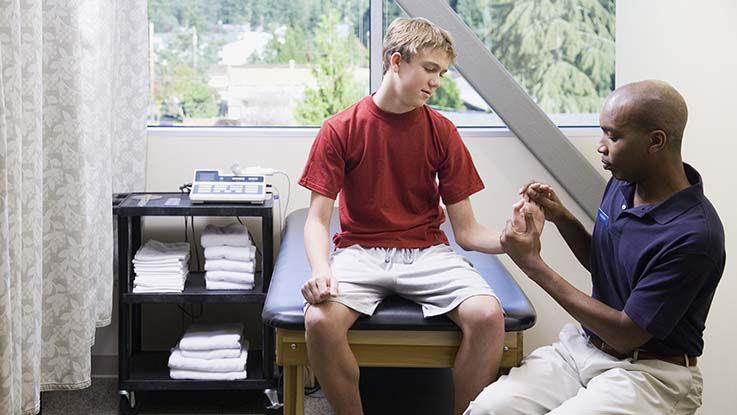Occupational and physical therapy for burn patients to make movement more comfortable
One of the most common parts of healing after a burn injury is that the skin feels tight and is difficult to move. This is a normal and frustrating part of healing from a burn. As it heals, burned skin shrinks, becoming tight and limiting your range of motion.
The best way to reduce skin tightness after a burn injury is through exercise. Occupational and physical therapy for burns is an important part of your rehabilitation. We’ll guide you through a personalized burn rehabilitation treatment plan designed to help you heal.
Why exercises are used for burn rehabilitation
Physical and occupational therapy is usually needed to help you heal properly from your
Our occupational and physical therapists will work closely with patients to design individualized exercise programs. Your exercise program might include cardiovascular and strengthening exercises, stretches to loosen the skin, and leisure activities.
We’ll also work with you to help you regain your independence. Our team of therapists are experts at teaching our patients how to safely perform daily activities such as eating, getting dressed, grooming, bathing and other movements you’ll need to do every day.
How often to exercise burns
It’s important to work on exercises every day, especially in the morning after waking up. Moving in the first part of the day will help stretch out tight skin, making moving throughout the day easier.
The burned skin is tightest and stiffest in the morning right after waking up. This is because when we sleep, we are not exercising or moving. This gives the burned or grafted skin a chance to shrink and tighten.
Common exercises for burn injuries
Our physical and occupational therapists will create a personalized treatment plan for you that uses targeted exercises and stretches to heal your burns. This program will help loosen tight skin and improve your mobility. Here’s what to expect from your burn physical therapy program:
Head and face exercises
There are several facial stretches you can do while recovering from burn injuries on the face. Making funny faces is a helpful way to stretch the skin and work the muscles.
Facial exercises we may recommend include opening you mouth wide, raising your eyebrows, shutting your eyes tightly, wrinkling your nose and pursing your lips.
Neck exercises
Stretching the neck skin after a burn is an important way to maintain your neck flexibility. Common stretches and exercises we recommend for the neck include looking up and down, looking from side to side, and watching TV while stretching your neck over a pillow.

Arm and hand exercises
Exercising your arms and hands after a burn is key to maintaining your range of motion and fine motor skills. When burns occur over the joints, scar tissue can tighten the skin and make it hard to move. Stretches and exercises help keep the skin loose so you can move more easily.
Arm and hand exercise plans may include activities you’d do at the gym like jumping jacks and lifting weights.
We’ll also ask you to do more precise movements with your hands like making fists, writing, holding and bouncing a small ball, and holding a fork, spoon or knife.
Leg exercises
If you’ve experienced burns on or around your knees, scar tissue can build up and make it difficult for you to walk, bend or straighten your legs. We’ll guide you through different leg exercises and stretches to prevent this from happening.
We’ll work with you to help you move independently so you can sit in a chair, get into bed, use the toilet, step into a bathtub, get into a car, and walk up and down stairs on your own.
Common exercise plans for leg burns include jumping jacks, lifting weights, riding a bike, and walking or running.
Pain management during physical therapy for burns
Stretching and moving the injured skin is often very painful. Our team of burn experts will work with you to help manage your pain so you can do the exercises you need to promote healing.
Strong pain medicines, like morphine, are used to make you as comfortable as possible. We’ll also teach you relaxation techniques to use in combination with pain management medicines. While we may not be able to relieve all pain caused by the burn, we’ll be able to help keep it at tolerable levels so you can get through your physical therapy program.